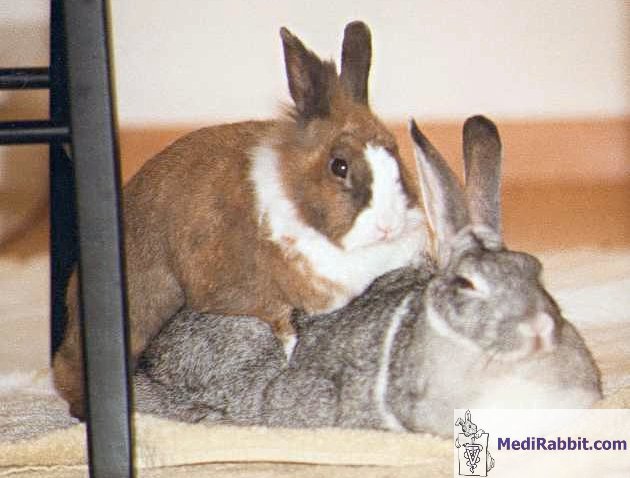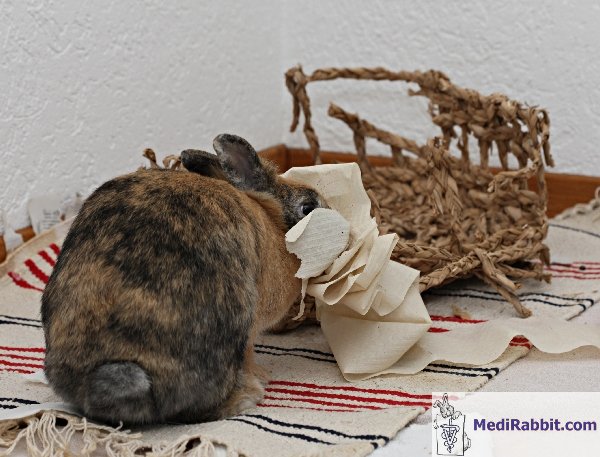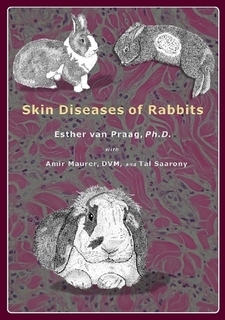Pseudopregnancy:
hay gathering and fur plucking behavior
Esther van Praag, Ph.D.
MediRabbit.com is funded solely by the
generosity of donors.
Every donation, no matter what
the size, is appreciated and will aid in the continuing research of medical care
and health of rabbits.
Thank you
|
Warning: this file contains
pictures that may be distressing for people.
|
Once a female rabbit reaches sexual
maturity, she may go through periodic false pregnancies. False pregnancies
can be triggered by the mounting behavior by a castrated male or another
female rabbit in an attempt to establish dominance, the presence of a
castrated or intact male in the same living environment. It is, however, also
observed in female rabbits that have no contact with other rabbits.
Pseudopregnancy is the result of ovulation and the
release of ova. The corpus luteum and the uterus begin to develop and
prepare for gestation and mammary glands may swell. Since there is no
fertilization of the ova, the levels of hormones that promote gestation
remain low. Around the 12th day of the pseudopregnancy, the corpus
luteum and the uterus start to regress, accompanied by mammary gland
involution. Between the 15th and 18th day, an increase
in estrogen secretion and a drop in progesterone level occurs. These changes
trigger maternal behavior and loosening of the hair. While building her nest,
the female rabbit will pull out abdominal or shoulder hair and begin frenetic
gathering of various materials (e.g., hay, paper) to use in its construction.
This behavior lasts 1 to 3 days, after which the rabbit resumes its usual
habits.
Hormonal
fluctuations cause the rabbit tremendous stress and can lead to
aggressiveness, growling and biting the days preceding the nest building.
Pseudopregnancies can become chronic when a female remains intact, increasing
the risk of developing reproductive disorders such as pyometra, hydrometra,
or uterine adenocarcinoma, and/or mastitis. Differential
diagnosis
Pseudopregnancy
should not be confused with abnormal fur chewing activities: fur chewed and
bitten off over the entire body, or this is performed on another rabbit when
living as a bonded pair or in a group. Causes include stress, the presence of
skin parasites, overcrowding, boredom, and seasonal factors. Fur-collecting
behavior should not be confused with the plucking and ingestion of fur
observed in nursing does or rabbits that suffer from mineral nutrient or fiber
deficiencies in their diet. Rarely gathering and transport of nesting
material is observed in castrated male rabbits. A nest is made, but there is
no fur plucking behavior. The etiology of this behavior is not well
understood; hermaphrodism or hormonal disbalance
have been ruled out. It usually stops
when the rabbit grows older.
Clinical
Signs
Nest building and hair pulling behavior
is indicative for pseudopregnancy when an intact female rabbit lives in an
environment with no other rabbits, or shares space with a neutered male
(neutered at least several weeks prior so that he is no longer able to
impregnate) or with another female. Extensive hair-pulling is indicative of
the end of a pseudopregnancy or gestation phase. Bald spots with healthy
looking skin appear on the dewlap, shoulders, or ventral abdomen, and expose
the nipples. Damaged or torn skin can result in secondary skin infections.
Treatment
The treatment of choice for
hormonally-driven fur-plucking behavior is ovariohysterectomy. This surgical procedure
will, furthermore, help prevent the onset of other fatal reproductive
disorders frequently observed in unaltered females, such as uterine cancer,
endometrial hyperplasia, mammary gland disorders. If pseudopregnancy is
accompanied by a secondary disorder or infection of the genital tract, it is
important to stabilize the health of the rabbit prior to surgery with
appropriate drugs and supportive treatment. For detailed information on
pseudopregnancy in rabbits: by Esther van Praag, Amir Maurer and Tal Saarony, 2010, 408 pages. $85.- AcknowledgementMy gratitude goes to Arie van Praag (Switzerland) and Kim Chilson (USA) and her rabbit
Carson for their pictures. Further Information
Meredith A, Flecknell P. BSAVA Manual of Rabbit
Medicine and Surgery Second Edition BSAVA, 1 Telford Way, Quedgeley,
Gloucester, GL2 2AB, UK. 2006 Quesenberry KE, Carpenter JW. Ferrets, Rabbits and
Rodents - Clinical Medicine and Surgery. Second Edition. WB Saunders,
Philadelphia, Pennsylvania, USA. 2004. |
e-mail: info@medirabbit.com













